When Lucy Gans was hired as a Lehigh professor in 1981, she wasn’t given an art studio. This, she decided, just wouldn’t work. So, she lugged her standardized office furniture and boxy ‘80s desktop computer into the hallway on the third floor of Chandler-Ullmann Hall, swapping them for a drawing table instead.
Now, Gans is once again creating a new studio for herself. This time, however, she’s deconstructing her Lehigh studio and transporting everything to her Allentown home as she prepares for retirement at the end of this school year.
After more than 40 years at Lehigh, now as an arts, architecture and design professor, Gans opened her final exhibition, Reading Between the Lines, at the Lehigh University Art Galleries on Sept. 8 to run through Dec. 9. The cohesively curated collection explores a variety of societal issues through sculpture, drawing and print work created over the last 20 years.
Her art, Gans said, often balances the personal and the political, featuring female-centric topics like pregnancy, maternity, sisterhood and rape, as well as human rights, COVID-19 and other social-based political issues.
Over the last five years, her work was primarily rooted in a technique of taking self-photographs, manipulating them in Photoshop, printing the same picture over itself multiple times to cause a blur effect, and overlaying text on the final image.
“It’s taking the thoughts and things that I encounter and putting it out there using myself, my body, my face, as sort of a vehicle to communicate all these horrendous things that are going on,” Gans said.
She said the pairing of text to an image makes her work more pointed and political by allowing her to allude to important topics through statistics, personal thoughts, poetry and more.
“We have free speech, and I’m not gonna go yell it on the street corner, but I’ll write it into my work,” Gans said.
She also frequently incorporates her loved ones into her art, such as through her work photographing hands, mainly those of her children, their partners and her grandchildren.
Gans said people tend to be far less insecure about their hands than their faces or bodies, allowing for genuine expression to show.
In one project, Gans presented sections of rose root to various members of her family and asked them to pose with the root however they saw fit. Some gently cradled the root while others gripped it tightly, each photograph uniquely representing the essence of the person the hands belonged to.
“My mother passed away in 2019, and I love these images of her hands,” Gans said. “When she was younger, I did some drawings of her, but I find the hands sort of more sentimental to me and represent her a little better than her face.”
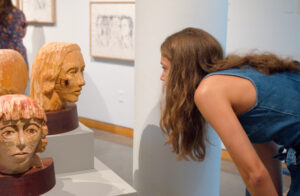
Emma Camp, ’24, stares into the face of a woman sculpted by Lucy Gans on Sept. 8 in the Lehigh University Art Galleries. Much of the work Gans included in her exhibition displayed female subjects or feminist messages. (Courtesy of Matthew Blum)
Although these photographs are directly related to her family, Gans said she hopes her work can be interpreted uniquely by all who view it and make them think deeper about their relationships and the human need for touch.
Sasha Fletcher, Gans’ son, said his mother’s work is even more powerful because of the deep connection formed by working with and from people who are important to her.
“You get such a stronger connection to something when you know in your heart the person whose face you’re carving or photographing,” Fletcher said.
The idea of family itself is deeply intertwined with art for Gans.
Growing up, Gans’ mother was a portrait painter who converted the family dining room into an art studio.
Gans said dining room chairs stayed stacked by the edge of the room next to the china closet, only to be taken down for Sunday family lunches. This left space for an easel and allowed the dining room trestle table to be converted into an artistic workspace. This table was handmade by Gans’ father: a businessman who built furniture as a hobby in between daily commutes to New York City.
When her mother was gone and her work was left unattended, Gans would sneak into the dining room and take her oil paints from that table, mixing them to recreate the colors in her portraits. She painted over the in-progress paintings, trying to color-match well enough that her mother wouldn’t notice her work had been tampered with.
“I would listen when she would come in and say, ‘Oh my God, what did I do to that mouth?’” Gans said. “I got better, and then at one point I had done something to the mouth and she didn’t even notice, and I thought, ‘OK, I’m learning.’”
This familial art experience followed Gans into her adult life. After returning to her undergraduate school, Lake Erie College, for her first professional teaching job, Gans met Les Fletcher, a graduate assistant in the painting department at the time.
Three years later, in 1977, they got married and moved to Allentown together in 1981 where they both began teaching nearby at Muhlenberg College and Lehigh University.
Sasha Fletcher, said he and his brother often visited Gans at her studio after school or spent summer weekends playing mid-’90s video games on the large, Lehigh computers. They would wander around her studio, which felt huge to them as young children, and marvel at the wooden sculptures she brought to life out of wood.
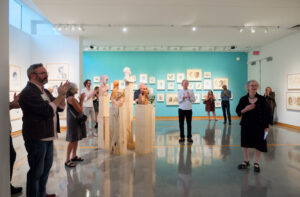
People applaud artist and professor Lucy Gans at the opening reception of her exhibition titled, “Reading Between the Lines,” on Sept. 8 in the Lehigh University Art Galleries. The exhibition will run through Dec. 9. (Courtesy of Matthew Blum)
“The smell of that room is something that’s always stayed with me,” Sasha Fletcher said. “I’m never entirely certain how to describe fresh-cut wood when the wood itself is not fresh. There is that smell of something that is alive but is sort of dried out, which gives it a sort of dustiness. And then you have that room itself which is stone, covered in years and years of industrial paint. There is all of that and there was the oil that was used to cure it.”
Gans’ art and the messages behind it were always present in her children’s upbringings. As a feminist artist, Gans would read them supplements from the League of Women Voters, instilling her morals into them at a young age, Sasha Fletcher said.
Gans said she often listens to radio news while she works, tuning into NPR and allowing her frustration with societal issues to inspire her creatively.
Art is the way she thinks, feels and reacts to the world, she said.. Everywhere she goes, Gans carries a small sketchbook with her and often finds herself sketching people or places she observes.
Despite her art being deeply influenced by her personal experiences and family, Jill Odegaard, an art professor at Cedar Crest College and long-time friend of Gans, said Gans’ work transcends the personal.
“She also reflects outwards, taking (in) societal concerns and issues,” Odegaard said. “Even though she’s working from a personal platform, she’s extending it outward.”
Gans said the upcoming end to her Lehigh career is bittersweet. She enjoyed her time teaching at Lehigh and intends to remain a part of the art community in her retirement, continuing to support her network of friends who teach at nearby universities.
Sasha Fletcher said it’s hard for him to imagine what his mother’s life will look like in retirement as she has worked at Lehigh throughout his entire life.
Even without her presence on campus, Odegaard said she is confident Gans’ legacy will be felt by the students and younger staff members that she’s influenced as a professor, mentor and artist.
Gans’ work, Odegaard said, leaves people with significant “food for thought” and opens doors for empathy to the people who view it.
Although she is retiring from teaching, Gans said art is something she will never be able to leave behind, as she believes it to be intuitively ingrained into people. She said even those who do not study art are often “closeted artists” who just haven’t been nurtured or given the opportunity to cultivate a skill.
“I think touching and creating is a basic human need,” Gans said. “Being able to shape and mold something with your hands is universal.”

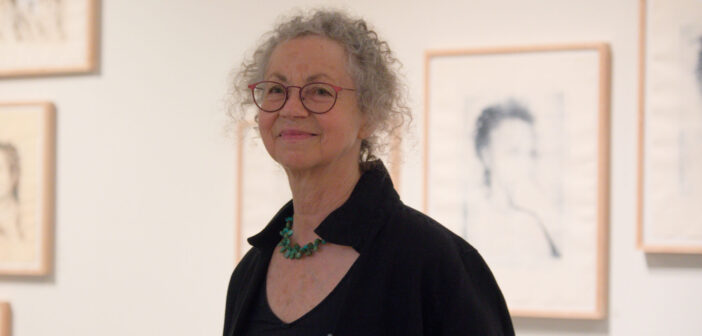

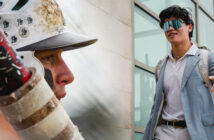
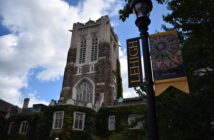

Comment policy
Comments posted to The Brown and White website are reviewed by a moderator before being approved. Incendiary speech or harassing language, including comments targeted at individuals, may be deemed unacceptable and not published. Spam and other soliciting will also be declined.
The Brown and White also reserves the right to not publish entirely anonymous comments.